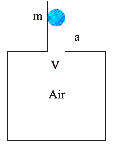A 5 kg collar is attached to a spring of spring constant 500 N . It slides without friction over a horizontal rod. The collar is displaced from its equilibrium position by 10.0 cm and released. Calculate
(a) the period of oscillation,
(b) the maximum speed and
(c) maximum acceleration of the collar.Solution in Bengali
(a) The period of oscillation as given by Eq. (14.21) is,
(b) The velocity of the collar executing SHM is given by,
and it occurs at x = 0
(c) The acceleration of the collar at the displacement x (t ) from the equilibrium is given by,
Therefore, the maximum acceleration is,
and it occurs at the extremities.
Topper's Solved these Questions
- BOOK - NCERT BANGLISHCHAPTER - OSCILLATIONSEXERCISE - Exercises27videos
OSCILLATIONS
- BOOK - NCERT BANGLISHCHAPTER - OSCILLATIONSEXERCISE - Additional Exercises6videos
OSCILLATIONS
- BOOK - NCERT BANGLISHCHAPTER - MOTION IN A STRAIGHT LINEEXERCISE - ADDITIONAL EXERCISES5videos
MOTION IN A STRAIGHT LINE
- BOOK - NCERT BANGLISHCHAPTER - SYSTEMS OF PARTICLES AND ROTATIONAL MOTIONEXERCISE - EXERCISES (TRUE OR FALSE)3videos
SYSTEMS OF PARTICLES AND ROTATIONAL MOTION
Similar Questions
Which of the following examples represent periodic motion?
03:07View SolutionAn air chamber of volume V has a neck area of cross section a into which a ball of mass m just fits and can move up and down without any friction (Fig.14.27). Show that when the ball is pressed down a little and released , it executes SHM. Obtain an expression for the time period of oscillations assuming pressure-volume variations of air to be isothermal [see Fig. 14.27].
 04:18View Solution
04:18View SolutionA boy standing on a stationary lift (open from above) throws a ball upwards with the maximum initial speed he can, equal to 49ms−1. How much time does the ball take to return to his hands ? If the lift starts moving up with a uniform speed of 5ms−1 and the boy again throws the ball up with the maximum speed he can, how long does the ball take to return to his hands ?
04:57View SolutionThe instantaneous speed of the point of contact during rolling is zero.
06:53View SolutionA 2.5 kg collar attached to a spring of foce constant 1000 Nm−1 slides without friction on a horizontal rod. The collar is displaced from its equilibrium position by 5.0 cm and released. Calculate (i) the period of oscillation (ii) the maximum speed of the collar and (iii) the maximum acceleration of the collar.
04:37View Solution500Nm−1 कमानी स्थिरांक की किसी कमानी से 5 kg संहति का कोई कॉलर जुड़ा है जो एक क्षैतिज छड़ पर बिना किसी घर्षण के सरकता है | कॉलर का उसकी साम्यावस्था की स्थिति से 10.0 cm विस्थापित करके छोड़ दिया जाता है | कॉलर के (a) दोलन का आवर्तकाल (b) अधिकतम चाल तथा (c ) अधिकतम त्वरण परिकलित कीजिए |
03:57View SolutionA 5 kg collar is attached to a spring of spring constant 500 N m^(-1) . It slides without friction over a horizontal rod. The collar is displaced from its equilibrium position by 10 cm and released. The time period of oscillation is
02:53View Solution26. 500 N/m. कमानी स्थिरांक की किसी कमानी से 5 kg संहति का कोई कॉलर जुड़ा है जो एक क्षैतिज छड़ पर बिना किसी घर्षण के सरकता है। कॉलर को उसकी साम्यावस्था की स्थिति से 10.0 cm विस्थापित करके छोड़ दिया जाता है। कॉलर के (a) दोलन का आवर्तकाल (b) अधिकतम चाल तथा (c) अधिकतम त्वरण परिकलित कीजिये। (NCERT)
02:16View SolutionA 10 kg collar is attached to a spring (spring constant 600 N/m.), it slides without friction over a horizontal rod. The collar iis displaced from the equilibrium position by 20 cm and released. What is the speed of the oscillation ?
03:46View SolutionA 5 kg collar is attached to a spring of spring constant 500 N m−1. It slides without friction over a horizontal rod. The collar is displaced from its equilibrium position by 10.0 cm and released. Calculate
(a) the period of oscillation,
(b) the maximum speed and
(c) maximum acceleration of the collar.01:25View Solution500 Nm^(-1) There is a 5 kg code collar attached to a segmental stool that slides on a horizontal rod without any friction. The collar is released by displacing 10.0 cm from its position of equilibrium. Calculate the (a) oscillation period of the collar (b) maximum speed and (c) maximum acceleration.
02:16View SolutionA 5 kg collar is attached to a spring of spring constant 500 N m−1. It slides without friction over a horizontal rod. The collar is displaced from its equilibrium position by 10.0 cm and released. Calculate
(a) the period of oscillation,
(b) the maximum speed and
(c) maximum acceleration of the collar.02:30View SolutionA 5 kg collar is attached to a spring of spring constant 500 Nm^(-1) . It slides without friction over a horizontal rod. The collar is displaced from its equilibrium position by 10 cm and released. Calculate (a) The period of oscillations (b) The maximum speed and (c) maximum acceleration of the collar.
03:24View SolutionA 5kg collar is attached to a spring of spring constant 500 Nm^(-1) . It slides without friction over a horizontal rod. The collar is displaced from its equilibrium position by 10.0 cm and released. Calculate the period of oscillation.
02:58View SolutionA 5 kg collar is attached to a spring of spring constant 500 N m−1. It slides without friction over a horizontal rod. The collar is displaced from its equilibrium position by 10.0 cm and released. Calculate
(a) the period of oscillation,
(b) the maximum speed and
(c) maximum acceleration of the collar.View Solution

